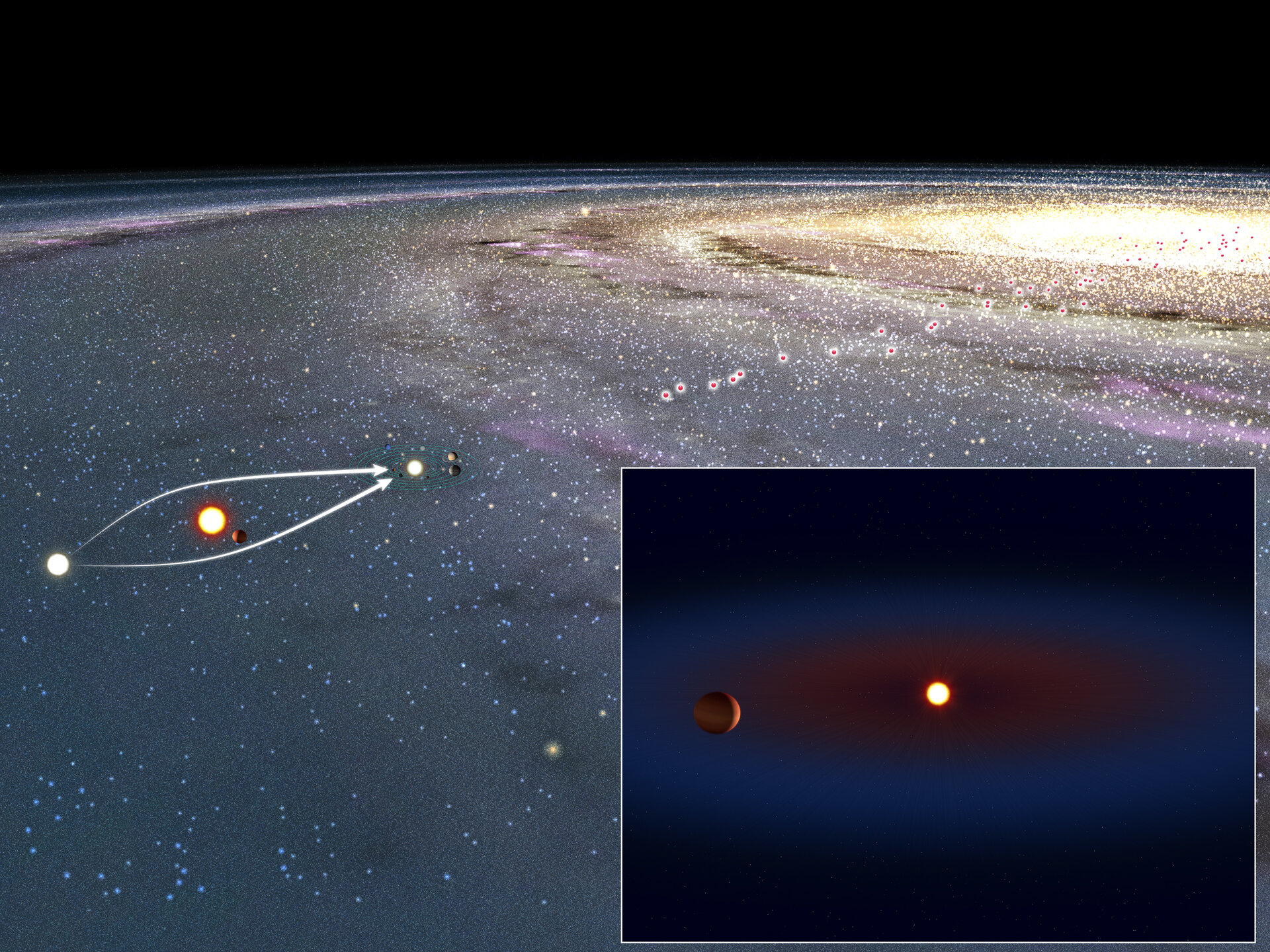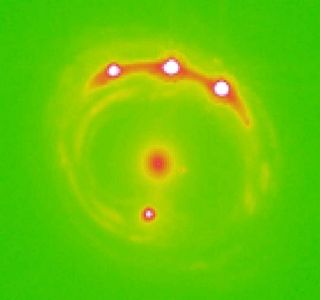|
|
Post by MartinT on Sept 12, 2019 14:49:28 GMT
Amazing to think what lifeforms could evolve on such planets. 111 light years away is relatively close, but so very, very far away. A generation ship could do it in, say, 40 generations at 0.1 light speed. Not much fun for the generations in the middle who never see a planet at all  |
|
|
|
Post by jandl100 on Sept 12, 2019 15:09:25 GMT
A generation ship could do it in, say, 40 generations at 0.1 light speed. Not much fun for the generations in the middle who never see a planet at all  I've read some generation ship science fiction, and sometimes the ship gets overtaken by the FTL* craft that had been invented after the ship set off. Such is the pace of technology advancement.  * Faster Than Light. |
|
|
|
Post by MartinT on Sept 12, 2019 16:22:34 GMT
That's just very bad luck, not even being the first to arrive!
|
|
|
|
Post by jandl100 on Sept 17, 2019 7:59:03 GMT
|
|
|
|
Post by jandl100 on Sept 27, 2019 11:19:43 GMT
Oh no, the universe seems to have got it wrong and allowed a gas giant planet to form in orbit around a star that is far too small.  www.theregister.co.uk/2019/09/27/gas_giant_dwarf_star/ www.theregister.co.uk/2019/09/27/gas_giant_dwarf_star/'Astroboffins baffled after spotting solar system with great gas giant that shouldn't exist. Back to the drawing board folks' 'Under the standard model of planet formation, the object known as GJ 3512 b should have never been born as it’s considered almost impossible for low-mass stars like GJ 3512 to harbour massive gas planets.' |
|
|
|
Post by MartinT on Sept 27, 2019 13:51:35 GMT
Perhaps it's a captured star, although they tend to have crazy orbits. Another mystery to solve.
|
|
|
|
Post by jandl100 on Sept 27, 2019 14:00:40 GMT
It's one way science progresses, find something that doesn't fit the theory so find a better theory!
|
|
|
|
Post by jandl100 on Oct 16, 2019 16:42:04 GMT
One of the 2019 Nobel Prizes went to the astronomers who in 1995 discovered the first planet around a sun-like star. Here is an interesting article explaining the science behind the discovery. astrobites.org/2019/10/16/the-nobel-winning-discovery-of-51-pegasi-b/They found a strange object orbiting the star 51 Pegasi, something twice the size of Jupiter, but about 7 times closer to its star than Mercury is to our sun. This new object made no sense with old models of planet formation — how could a Jupiter-like planet be so close to its star? |
|
|
|
Post by jandl100 on Nov 2, 2019 6:57:14 GMT
An exoplanet has been discovered orbiting a nearby star through a rare phenomenon known as gravitational microlensing. 'On November 1, 2017 amateur astronomer Tadashi Kojima in Gunma Prefecture, Japan reported an enigmatic new object in the constellation Taurus. Astronomers around the world began follow-up observations and determined that this was an example of a rare event known as gravitational microlensing. Einstein's Theory of General Relativity tells us that gravity warps space. If a foreground object with strong gravity passes directly in front of a background object in outer space this warped space can act as a lens and focus the light from the background object, making it appear to brighten temporarily. In the case of the object spotted by Kojima, a star 1600 light-years away passed in front of a star 2600 light-years away. Furthermore, by studying the change in the lensed brightness, astronomers determined that the foreground star has a planet orbiting it.'  phys.org/news/2019-11-worldwide-nearby-lensing-exoplanet.html?fbclid=IwAR3Gs2Xyj0gPU72w5WKZcpjrCBPszvGTWhalTY2xjo7AvJoMtiXsYHp2WJ0 phys.org/news/2019-11-worldwide-nearby-lensing-exoplanet.html?fbclid=IwAR3Gs2Xyj0gPU72w5WKZcpjrCBPszvGTWhalTY2xjo7AvJoMtiXsYHp2WJ0 |
|
|
|
Post by MartinT on Nov 2, 2019 8:56:02 GMT
Clever. 1600 light years distance is a nearby star, always gets me.
|
|
|
|
Post by jandl100 on Dec 4, 2019 22:00:28 GMT
Giant planet found around tiny white dwarf star. Astronomers just found a giant planet orbiting a white dwarf for the first time, providing a glimpse into the fate of our solar system. The planet is Neptune-sized and is four times the size of the star, and is losing 260 million tons of material every day as it's blasted by residual heat from the smoldering stellar core. Artist impression ...  "This discovery is major progress, because over the past two decades, we had growing evidence that planetary systems survive into the white-dwarf stage," "We've seen a lot of asteroids, comets and other small planetary objects hitting white dwarfs, and explaining these events requires larger, planet-mass bodies further out, having evidence for an actual planet ... is an important step." www.space.com/alien-planet-detected-around-white-dwarf-first-discovery.html |
|
|
|
Post by MartinT on Dec 5, 2019 6:28:49 GMT
That might help our Neptune to survive, but it'll be curtains for Earth and the inner planets.
|
|
|
|
Post by jandl100 on Dec 5, 2019 8:07:48 GMT
Yup, Earth is future history - but we [or our successors] have got 5 billion years to figure out what to do about it.
We'll be mingling with the Andromeda galaxy by then, so who knows what will be happening.
|
|
|
|
Post by jandl100 on Dec 16, 2019 21:45:11 GMT
I think I've mentioned this exoplanet discovery before, elsewhere. But it's so totally mind blowing that it's worth going into again, with a bit more detail.  No, that isn't a pic of exoplanets. The red circular blob in the middle is a distant galaxy. It's in the way of an even more distant and very powerful 'active' galaxy, a quasar. The light from the quasar whizzes past the intermediate galaxy on its way to us, and due to the galaxy's mass the quasar light bends around the galaxy, just a little. It does this in such a way that 4 'images' of the distant quasar reach us, each one having passed along a different path around the intermediate galaxy. Those are the 4 white blobs. OK, are you still with me?  Careful analysis of the differences between the 4 images of the quasar gives strong hints about the makeup of the intermediate galaxy, and the most probable cause of the observed differences is the presence of about 2 trillion free-floating planets with sizes between our own moon and Jupiter, i.e. planets not in orbits around stars, but which presumably have been ejected from their original solar systems by chaotic gravitational interactions. Now, if that most probable interpretation is correct, and if that intermediate galaxy is a typical one [it seems normal], then there are about 2,000 free-floating large planets for each star in a galaxy. So, while our own solar system has a dozen or two such moons and planets in their seemingly stable orbits, there are 2,000 or so planets that have been ejected from around the sun and are now careening through interstellar space, cold and dark and very difficult to detect. My jaw dropped when I first came across this - come to think of it, it still does! |
|
|
|
Post by MartinT on Dec 16, 2019 22:10:22 GMT
That's proper science. Respect.
|
|
|
|
Post by Firebottle on Dec 17, 2019 7:50:28 GMT
I just love the lensing effect but I am finding it difficult to comprehend 2000 random planets per star.
Is this where the missing mass is, rather than dark energy?
|
|
|
|
Post by jandl100 on Dec 17, 2019 8:39:54 GMT
I just love the lensing effect but I am finding it difficult to comprehend 2000 random planets per star. Is this where the missing mass is, rather than dark energy? Yes, mind boggling, isn't it. Missing mass, no, sadly - we're still stuck with the unknown 'dark matter'. [Dark energy is a different thing]. Even if all the free floating planets [ffp] were as large as Jupiter [very unlikely, I'm sure the average ffp mass will be much smaller] Jupiter is only 0.1% of the sun's mass. If the average ffp is Earth sized, then it would need 333,000 of them to equal the mass of the sun. So a mere 2,000 would be insignificant. But, I think the distribution of ffp mass is all guesswork atm - more research needed! |
|
|
|
Post by jandl100 on Dec 18, 2019 9:14:48 GMT
Our solar system appears to be extremely unusual in its makeup of planets. astrobites.org/2019/12/17/why-are-there-so-many-sub-neptune-exoplanets/'In the few decades since the discovery of the first exoplanet in 1992, we’ve realized that our own solar system is just plain weird. We have no hot Jupiter gas giant planets whizzing around our star in a matter of days, nor do we have any sub-Neptune planets, the most common type of planet in the galaxy.' There are distinct and strong selection effects with our current exoplanet discovery techniques. It's much easier to detect large planets orbiting close in to their star. Nonetheless, even allowing for that, it does seem that our own solar system is a very unusual place. |
|
|
|
Post by MartinT on Dec 18, 2019 10:41:24 GMT
Cause and effect. It is possible that our strange solar system made the existence of Earth possible, with the outer gas giants protecting us by their gravitational 'sweeping up' of asteroids and other objects. If we look for solar systems like ours, we may identify potential locations for life.
|
|
|
|
Post by jandl100 on Dec 18, 2019 11:42:03 GMT
The problem is finding them - I don't think we've found any yet.
If they are indeed very rare, then maybe that's the Fermi Paradox solved - where are the aliens? There aren't any closer than a zillion light years because habitable solar systems almost never happen.
|
|